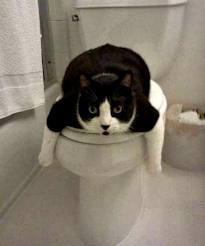Urinary Issues such as spraying, marking, urinary tract infections and urethral obstructions. These events may happen once or multiple times, a singular event or related. It is always most important to rule out a medical problem before assuming that your cat is just being “bad” or upset about something. Urinary obstructions are responsible for a wide variety of behavioral signs, and can be fatal in 72 hours or less if untreated, so a veterinary exam is most important.
Non Spay/Neuter Pets (Spraying and Aggression)
Identifying the cause is necessary to determine whether the urination is a health issue or behavior. Common factors may include whether a pet has been spayed or neutered. No matter the cause, however, it is most important to stay calm and remember that your pets behaviors are also their means of expression.
If your pet is not spayed or neutered, behavior problems can arise. The best way to prevent aggression is to have this safe, routine procedure performed at an appropriate age. This generally reduces aggressive behaviors, bad temperaments, litter box problems, and the risk of running away, as well as the potential for unintended pregnancies.
Once spayed or neutered, keep in mind that it may take up to one month after the surgery for the cat to exhibit appropriate behavior. You will find that once you pet is spayed/neutered the urine smell will decrease, Urine Marking for territory and Aggression will Stop.
Health Issues
Sometimes a cat will suddenly act aggressive or start to urinate outside the litter box it may be medical reasons. Any abnormal behavior or sudden change in behavior should be checked out by your veterinarian as soon as possible. If you spend time with your cat and get to know him, you will notice any changes in his behavior and habits right away. If there is a sudden change, don’t assume your cat is misbehaving. Check with your veterinarian first.
Signs seen with a Urinary Tract Infection
Urinary problems are commonly seen in dogs and cats. Symptoms can range from “obviously sick” to very few signs seen, depending on the length and severity of infection. Being familiar with possible warning signs could help save your pet’s life.
Urinary tract infections are classified as “upper” or “lower”. An infection of the kidneys is an upper urinary tract infection, an infection of the bladder and urethra is a lower urinary tract infection.
The following clinical signs can be seen with pyelonephritis, urinary tract infections, urinary calculi (bladder stones), prostatitis (prostate inflammation or infection), and some urinary tract cancers. Any combination of the signs may be seen.
- unable to urinate
- straining to urinate – before, during or post urination – may be misinterpreted as constipation
- painful urination, whining
- bloody urine
- foul-smelling urine
- cloudy urine
- urinary “accidents” or urinating out of the litter box for cats
- urinary incontinence (dribbling, leaking while sleeping)
- drinking and urinating more often than usual
- painful abdomen (belly area)
- excessive licking of genital area
- lethargic
- not eating, decreased appetite
- vomiting and/or diarrhea
What Causes Lower Urinary Tract Problems in Cats?
- Stones, crystals or debris accumulation in the bladder or urethra
- Urethral plug (accumulation of debris from urine)
- Bladder inflammation or infection
- Incontinence from excessive water drinking or weak bladder
- Injury to, or tumors in , the urinary tract
- Stress
- Spinal cord problems
- Congenital abnormality
Simple Treatments
Your first step is to get immediate veterinary care. Depending on your cat’s prognosis, one of the following may be recommended:
- Antibiotics or other medications
- Dietary changes
- Increase in water intake
- Urinary acidifiers
- Expelling of small stones through urethra
- Surgery to either remove bladder stones or tumor, or to correct congenital abnormality
- Urinary catheter or surgery to remove urethral blockage in male cats
- Fluid therapy
* There are herbal remedies that may help.
Behavioral issues
It may be tempting to write off symptoms such as inappropriate urination as “bad” behavior, but medical problems should always be ruled out first. Urinary problems can quickly (within hours) become a life-threatening medical emergencies if an animal becomes blocked. Prompt attention and care are essential.
Once your veterinarian rules out a physical problem, then you should start to unravel the problem by looking at what’s going on in your cat’s life. Watch carefully and find out when and where she is eliminating inappropriately, and what’s happening in the household at the time. Recognizing the reasons for litter box avoidance and addressing the cause will help you find a solution to the problem. With understanding, patience, and persistence, most such problems can be overcome.
Your cat is trying to signal something. Cats use elimination of urine (and sometimes feces) for communication – a kind of pee-mail, if you will. That can be a sign that something is wrong. In the latter situation, your kitty is not being mean or spiteful. She’s got a problem and you’ll have to figure out what it is if you want it to go away.
Punishing your cat for inappropriate elimination will not solve the problem. It will only teach her to fear and avoid you, and eliminate when you’re not around. In fact, it can actually make the problem worse, since inappropriate elimination is often caused by stress, and punishment will only add to her stress level.
Here are the top reason of behavioral Issues.
1) Dirty Litter Box. (How many time to you flush your toilet?)
Clean the box often. Scoop out the soiled litter and solid wastes daily or twice a day, and change the litter and scrub the box with warm, soapy water weekly if you are using regular clay litter. Don’t use harsh cleaners, such as bleach, to clean the box; they may offend your cat’s delicate sense of smell further and add to the problem.
You might want to try a clumping litter. With clumping litters, the litter needs changing less frequently, and still remains relatively odor free. By scooping out the clumps and solid wastes once or twice a day, depending upon the number of cats you have, you can make all but the most sensitive cats happy. Ultimately, you and your cat will have to reach an agreement on the cleaning frequency.
2) Where are you putting you litter Box?
Location is also vital. If your cat doesn’t like the litter box’s location, she may not use it. For example, if you place the litter box too close to her food and water dishes, she may avoid the box since cats don’t like to eat and eliminate in the same area. If the box isn’t easily accessible – for example, down in the basement or up on the top floor – she may not be able to get there in time, or may think it’s too much trouble. If she has to brave some stressor to get to the box, such as a noisy water heater, the washer and dryer, or a dominant cat’s territory, she may look for a safer place to eliminate. Cats like quiet, safe, private places to do what they have to do. Follow your cat and observe what’s going on.
If location is the problem, move the litter box to an area that allows the cat privacy but is accessible and convenient for cleaning. Some people prefer keeping the box in the bathroom, but in a multi-cat household that can get crowded. Consider using a closet in a spare bedroom or a well-ventilated porch with easy access. Some owners locate litter boxes in a rarely frequented second bathroom or even in the bathtub. Try several locations until you find one she will use consistently.
Change location for older pets. Even is your Pet use to go in the litter box it may be difficult to get to the old location once you pet is older or if you added additional pets or family members to your household.
3) Litter Brand Change
If a change in litter box behavior occurs after you’ve switched the type or brand of litter, try changing back. Your cat may not like the new litter. Cats are individuals and what appeals to one cat may not appeal to another. Some are highly perfumed to mask odors from human noses, but perfumes are offensive to some cats; other litters just don’t have the right feel. Cats evolved from desert animals and a litter with the texture of sand is usually well accepted. Avoid Pine litter as it may cause upper respiratory.
If you are bringing a formerly outdoor cat indoors, and he is not using the litter box, it could be that the litter is not what he’s used to. Try filling the box with clean dirt or sand – whatever he’s been using in the yard. After he’s using the box consistently, very gradually, over the next two or three weeks, mix the dirt with increasing amounts of the litter you want him to use.
4) Box Issues
The size, shape, and depth of the litter box can also affect your cat’s behavior.She may reject the box if, for some reason, she doesn’t like it. Hooded litter boxes are popular with some cats, but most don’t like the confining nature of them and feel trapped when using such a box – a particular problem in multicat households with dominance disputes. Large or overweight cats may find the opening to a covered box too small, or may not have enough room to maneuver inside such a box, and longhaired cats may have trouble keeping their fur clean.
Older cats, or cats with health problems, such as arthritis, may have trouble stepping into boxes with high sides, or into boxes with smaller openings. If cats have any health problem that makes movement difficult, provide a sturdy ramp in front of the box, and a step down inside, if needed.
Some cats dislike litter box liners. Remove the liner if you notice your cat pulling it up or leaving claw marks in the plastic. Providing several boxes of different sizes and types may help resolve the litter box problem.
5. Environmental Changes
Cats are creatures of habit and they don’t like changes in their environment. If your cat stops using the litter box after a change has taken place in the household, it could be that the change is causing her to become anxious. Anxiety is one of the more common feline emotional problems, and may contribute to a number of behavior problems, including house soiling. Have you just brought home a new child, spouse, family member, or pet? Have you moved or remodeled the house? Have you recently changed your routine – gone back to work, say, after being at home all day? Even healthy cats can become stressed and anxious by changes that might seem minor to you. Look at the situation from the cat’s viewpoint and see what might be going on.
During household changes, reassure your cat, give him extra attention and treats, and keep the litter box squeaky clean. This will help him regain his feeling of safety and routine, and help him adjust more quickly.
6. Territorial Disputes
If you have more than one cat, disputes can arise over litter box usage. Cats are territorial by nature. Their societies are sometimes structured in a hierarchical manner, governed by strict rules of conduct. In multicat households, the dominant cat will sometimes leave her feces uncovered as a form of scent marking, to announce her presence and status. Uncovered feces mean that the territory is taken. If the other cats feel they’re encroaching on a dominant cat’s territory, they’ll be reluctant to use that box.
Also, some cats don’t like sharing their litter box with other cats. The solution is to provide a litter box and a private location for each cat. As a rule, you should have one litter box for every cat in the household. Also, consider keeping an extra box in another location to circumvent disputes or clashes. If a cat doesn’t want to approach the main box area while another cat is there, she can detour to the other box to do her business. This prevents the cat from choosing a less acceptable location if the need is urgent.
7. Overcrowding
only multicat households. Make sure you can provide facilities for each of your cats. You can also expand the territorial range by adding cat trees, outside enclosures,cut holes in several cardboard boxes, turn them upside down, and place them strategically. Make sure each cat is given enough love and attention, too.
8. Spraying
This marking behavior is not connected to other litter box problems, because the reason for the behavior is completely different. Unaltered male and female cats spray urine to mark their territory. While more common in males, both genders can spray. Spraying has sexual and dominance-type connotations; the behavior being most prevalent in intact cats with a full complement of sex hormones. This is why spaying and neutering usually ends the behavior.
It’s easy to tell the difference between spraying and urinating. During spraying, the cat backs up to a vertical surface, raises his tail (which often quivers), treads, and sprays urine onto the vertical surface. This is as opposed to squatting to urinate. Spaying and neutering often eliminates spraying and is the first step to take toward resolution of the problem.
However, spraying can also be a sign that a neutered male or spayed female cat has some issues related to anxiety or stress (e.g. a territorial dispute or a disturbance in their routine). Battles for dominance or territory may cause spraying in a multicat household, regardless of the cats’ neuter status, and you’ll need to resolve the dispute before the behavior will cease. A project such as this can be challenging. Spraying may also occur if a reclusive cat sees other cats outside in the yard, an area he likely considers an extension of his territory. One little wrinkle in the diagnosis of stress-related urine marking is that it does not always occur in the form of spraying. Sometimes urine marking may be performed from the squatting posture. The key to diagnosing this curve ball delivery is to pay attention to the sites on which urine is deposited. Litter box problems result in deposition of urine in relatively uninteresting “other” locations, usually on rugs or carpets in out-of-the way locations that are convenient for the cat. Horizontal urine marking, however, might be found on a person’s possessions, on new things brought into the house, on a particular bedspread, on the stovetop, on a heating register, etc. When the location of urine deposition becomes as interesting (or perplexing) as this, consider anxiety-related urine marking, even if the cat “performs” in the squatting posture.
Urine-marked areas must be well cleaned with a non ammonia-based cleaner and then the area should be blocked off so that the cat no longer has access to it for a while, or the significance of the area can be transformed by moving the food dishes there. Products for cleaning pet stains that contain enzymes or bacteria work by eliminating odor-causing chemicals. Such products are usually effective. It’s important to remove all traces of the urine (and/or feces) or the scent will attract kitty back to the spot. But you need to address the problem’s underlying cause to end the cycle of inappropriate elimination; otherwise, your cat will just move to another area to spray. Ask your veterinarian for advice if you’re stumped for a solution. Certain medications combined with behavior modification techniques can help resolve the problem. We have found that the medication Amitripyline anxiety medication for dogs and cats has been affective for this behavior.
Remember:
- Don’t perform disliked procedures, such as pilling and nail clipping, near the litter box. Your cat may associate these activities with the litter box and avoid it.
- Don’t try to catch your cat to perform disliked procedures (such as those listed above) while he’s using the litter box.
- Don’t do anything else that might cause your cat to associate its litter box with unpleasantness. E.g. Don’t force him into the box after an accident; don’t punish your cat when he’s near the litter box (or any other place, for that matter).
- Don’t rub the cat’s nose in urine or feces if he eliminates outside the box.
- Don’t use harsh disinfectants or cleaners to clean the litter box.
- Do check with your veterinarian to rule out possible medical contributions.
- Do clean the box daily.
- Do make sure your cat has a quiet, private, stress-free litter box location.
- Do praise and reward your cat when he uses the box correctly.
*We have found that the medication Amitripyline anxiety medication for dogs and cats has been affective for behavior issues.



